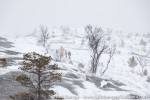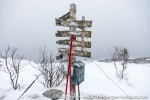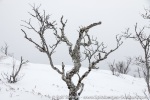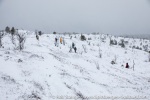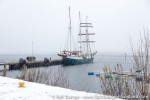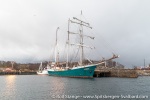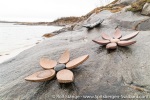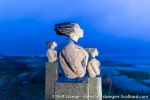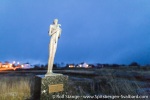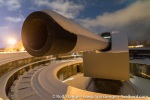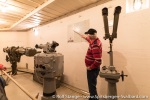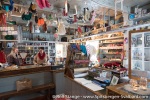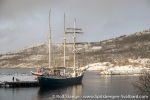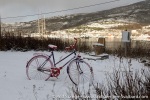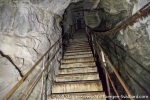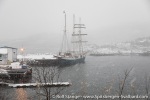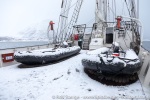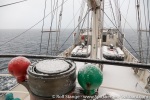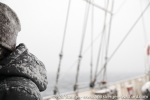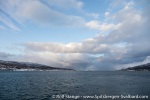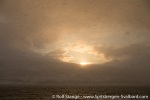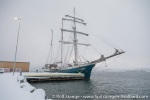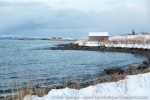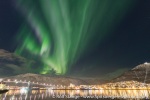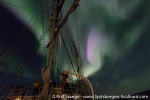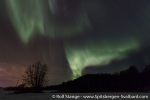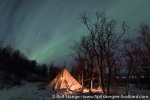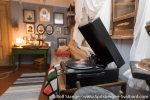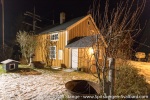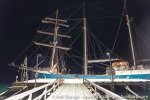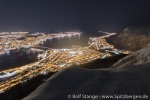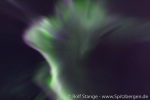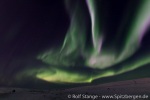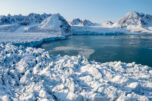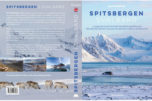-
current
recommendations- Liefdefjord
New page dedicated to one of Spitsbergen's most beautiful fjords. Background information and many photos.
- New Spitsbergen guidebook
The new edition of my Spitsbergen guidebook is out and available now!
- Liefdefjord
New page dedicated to one of Spitsbergen's most beautiful fjords. Background information and many photos.
Page Structure
-
Spitsbergen-News
- Select Month
- June 2025
- May 2025
- April 2025
- March 2025
- February 2025
- January 2025
- December 2024
- November 2024
- October 2024
- September 2024
- August 2024
- July 2024
- June 2024
- May 2024
- April 2024
- March 2024
- February 2024
- January 2024
- December 2023
- November 2023
- October 2023
- September 2023
- August 2023
- July 2023
- June 2023
- May 2023
- April 2023
- March 2023
- February 2023
- January 2023
- December 2022
- November 2022
- October 2022
- September 2022
- August 2022
- July 2022
- June 2022
- May 2022
- April 2022
- March 2022
- February 2022
- January 2022
- December 2021
- November 2021
- October 2021
- September 2021
- August 2021
- July 2021
- June 2021
- May 2021
- April 2021
- March 2021
- February 2021
- January 2021
- December 2020
- November 2020
- October 2020
- September 2020
- August 2020
- July 2020
- June 2020
- May 2020
- April 2020
- March 2020
- February 2020
- January 2020
- December 2019
- November 2019
- October 2019
- September 2019
- August 2019
- July 2019
- June 2019
- May 2019
- April 2019
- March 2019
- February 2019
- January 2019
- December 2018
- November 2018
- October 2018
- September 2018
- August 2018
- July 2018
- June 2018
- May 2018
- April 2018
- March 2018
- February 2018
- January 2018
- December 2017
- November 2017
- October 2017
- September 2017
- August 2017
- July 2017
- June 2017
- May 2017
- April 2017
- March 2017
- February 2017
- January 2017
- December 2016
- November 2016
- October 2016
- September 2016
- August 2016
- July 2016
- June 2016
- May 2016
- April 2016
- March 2016
- February 2016
- January 2016
- December 2015
- November 2015
- October 2015
- September 2015
- August 2015
- July 2015
- June 2015
- May 2015
- April 2015
- March 2015
- February 2015
- January 2015
- December 2014
- November 2014
- October 2014
- September 2014
- August 2014
- July 2014
- June 2014
- May 2014
- April 2014
- March 2014
- February 2014
- January 2014
- December 2013
- November 2013
- October 2013
- September 2013
- August 2013
- July 2013
- June 2013
- May 2013
- April 2013
- March 2013
- February 2013
- January 2013
- December 2012
- November 2012
- October 2012
- September 2012
- August 2012
- July 2012
- June 2012
- May 2012
- April 2012
- March 2012
- February 2012
- January 2012
- December 2011
- November 2011
- October 2011
- September 2011
- August 2011
- May 2011
- April 2011
- March 2011
- February 2011
- January 2011
- December 2010
- November 2010
- September 2010
- August 2010
- July 2010
- June 2010
- May 2010
- April 2010
- March 2010
- February 2010
- November 2009
- October 2009
- August 2009
- July 2009
- June 2009
- May 2009
- April 2009
- March 2009
- February 2009
- January 2009
- December 2008
- November 2008
- October 2008
- August 2008
- July 2008
- June 2008
- May 2008
- April 2008
- March 2008
- February 2008
- April 2000
- Select Month
-
weather information
-
Newsletter

| Guidebook: Spitsbergen-Svalbard |
Home
→ October, 2019
Monthly Archives: October 2019 − News & Stories
Skarberget & Tranøy
Thu
31 Oct
2019
We are a good bit further south and now we are in the Lofoten area. Not yet Lofoten proper, but we could see them from here if it was clear. “Here” is Tysfjord, a large, beautiful fjord that is cutting into Norway opposite of the northern Lofoten islands.
You can make lovely hikes in this area. We opt for Skarberget. Weather-wise, it took a bit of motivation, but then … it is great as soon as you are out there, with snow and fresh wind! The views are not quite as amazing as they might be on a clear day, though.
Gallery – Skarberget & Tranøy
- gallery anchor link: #gallery_1777
Click on thumbnail to open an enlarged version of the specific photo.
Later we move over to Tranøy. Again some amazing maneouvring by Mario to get alongside in this tiny littl port. The art park of Tranøy is waiting for us! Who cares about cold, darkness and rain if you can go out and see various pieces of art!
Yes, the weather. Could be better.
Skrolsvik & Harstad
Wed
30 Oct
2019
We arrive at Skrolsvik on the southwestern point of Senja at breakfast time. Sun and snow are bathing the landscape in ever-changing winter light.
You can do everything from short walks to mountain climbing here. We are happy with a good walk up a mountain slope or an easy walk following a path to the coast. There are also some fortifications here which the Germans built during the war.
The owners of the old store („Gammelbutikken“) are so kind to open especially for us. The lovely wooden building was built in 1870 and it served as the local store for all kinds of daily use stuff from 1925 to 1992. Now it is kept as kind of a museum. And you can still buy all sorts of lovely things here.
Gallery – Skrolsvik and Harstad
- gallery anchor link: #gallery_1765
Click on thumbnail to open an enlarged version of the specific photo.
Then we continue to Harstad on the island of Hinnøya which belongs to Vesterålen. The Germans (again …) put up some crazy guns and fortifications here during the war. The historical museum and the medieval church are unfortunately closed today.
Skjervøy, Nord-Lenangen
Tue
29 Oct
2019
We departed late night from Finnkroken and set course to the northeast, to Skjervøy, with high hopes to find orca that had been seen there recently. But the weather had different ideas. It did not make much sense to try to find whales in force 6-7 winds, so we just turned and set sail, which was lovely in the snow …
Gallery – Tromsø – Finnkroken
- gallery anchor link: #gallery_1762
Click on thumbnail to open an enlarged version of the specific photo.
… and a couple of hourse later we were in Nord-Lenangen, a calm little place in a silent fjord – lovely winter scenery and atmosphere!
Later, back on board, we got into the northern light mode and made preparations for further sightings by having a look at the photography side of it (if you are interested, then have a look at Rolf’s northern light page for a refresher). Then we set course to the south, passing Tromsø, and then heading for Senja.
Tromsø-Finnkroken
Tue
29 Oct
2019
A lovely early winter day in Tromsø, on 70 degrees north – cold and clear, calm and sunny.
Everybody is coming on board SV Antigua in the late afternoon. It feels like late evening, but it is really just the late afternoon – sunset just after 15.00 hours and it is kind of getting dark an hour later.
But the lights up there are turned on again. First class northern lights! We enjoy the magic in the harbour, with the lights above the long bridge and the famous cathedral, and during the first miles of our voyage.
We go alongside after two hours sailing in Finnkroken on the island of Reinøya. A tiny little pier and the chance for an evening walk and to put the tripod up on solid ground – the northern light show is still going on.
Gallery – Tromsø – Finnkroken
- gallery anchor link: #gallery_1759
Click on thumbnail to open an enlarged version of the specific photo.
We get a very warm welcome. What a pleasant surprise! There are indeed people here who do not mind to see tourists! Jo Martin is one of a dozen people who are living here (is it really that many?). He is the owner of an old trading post next to the pier. It was founded in 1802 and it is really a bit of a time capsule! At the same time, there is a path into the wood which is marked by torches, so we can easily find the way to a lavvo (large tent) which is heated by a fire inside – while the northern lights are dancing on the sky! How good is that!? Incredible! What a great start into the voyage!
Tromsø – 26th October, 2019
Mon
28 Oct
2019
The polar night is about to start – the last sunset and sunrise in Longyearbyen are today. In Tromsø, we are about to start again, exploring the north under sail with SV Antigua. The light of the north, northern lights, beautiful landscapes and places with a taste of winter, orcas – that is a substantial part of our wishlist for the next week.
But now, there is still time to get a few things done here in Tromsø. New Spitsbergen driftwood picture frames and kitchen slats need to get on their way (I thought I may just mention that 🙂 ), I want to meet some friends and in the evening, there are some impressive fireworks on the night sky!
Gallery – Tromsø – 26th October 2019
- gallery anchor link: #gallery_1756
Click on thumbnail to open an enlarged version of the specific photo.
Spitsbergen-reindeer: new and complete population count
The Spitsbergen-reindeer, also known as Svalbard-reindeer, has seen a lot of ups and downs since it came to Spitsbergen from the Russian Arctic thousands of years ago. It became a sub-species on its own which is not found anywhere outside Svalbard. Nevertheless, it was hunted almost to extinction until it was finally protected by the Norwegian government in 1925 – soon after the Spitsbergen Treaty had given Norway the power to do this. Estimates of the reindeer population from the early 20th century are a mere 1000 animals – for the whole Spitsbergen archipelago!

Spitsbergen-reindeer: two strong males. Straumsland, east Spitsbergen.
Spitsbergen reindeer can disperse, and while doing so, they can cross glaciers, solid fjord ice and even drifting sea ice. Otherwise, they would obviously never have made it to Spitsbergen in the first place. But as long as they are happy in a given area, they tend to stay where they are, so it can take many decades until they re-populise remote areas where they became extinct in the past.
The local populations are subject to strong dynamics. Weather extremes are an important factor: in bad years, when strong rainfall on snow-covered ground in the winter with subsequent freezing covers the tundra with a layer of ice, many reindeer can starve to death later when the fat reserves are used up and the vegetation is still under ice. This is especially the case when the population is actually already too big for the area. In Adventdalen near Longyearbyen, the population has doubled in the last 10 years.
Other reindeer may die during accidents in steep and slippery terrain after winter rainfall. In the winter of 2018-2019, several reindeer died in the vicinity of Longyearbyen, where strong rainfall occurred in December. Some had obviously fallen down steep slopes, while have probably starved to death later. In such cases, local populations may experience a significant decrease. If such episodes happen several times over subsequent years, it may even lead to local exctinction. The event of the 2018-19 did, however, not have significant consequences for the local population.
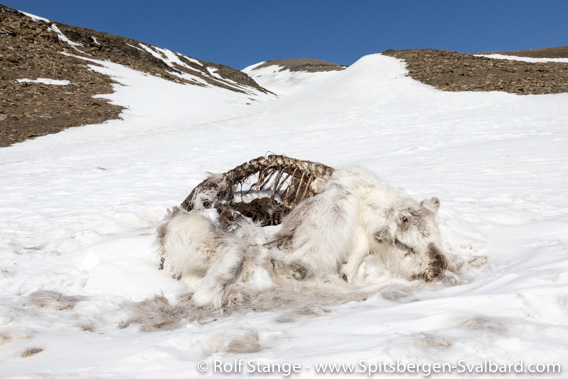
Dead Spitsbergen-reindeer at Operafjellet, east of Longyearbyen:
the exact cause of death is unknown, but either falling down from a steep, icy slope or starvation are likely.
On the other hand, the population may increase again quickly in good years. In spring 2017, for example, reindeer in Adventdalen increased quickly again in numbers due to favourable conditions.
Next to weather fluctuations, climate change is an important factor on a longer time scale, moving from months and single years (weather) up to decades (climate): an increasing frequency of strong winter rainfall may make life more difficult for reindeer, while more luxurious growth of tundra vegetation can provide more food, supporting a bigger population. Currently it seems as if Spitsbergen reindeer benefit from increased vegetation growth at least in some areas. On top of that comes the population recovery after the ban on hunting in 1925, a development that is probably still going on as reindeer continue to move back to areas where there were no reindeer in decades during the 20th century.
It becomes evident that reindeer population dynamics are a complex matter which is influenced by a number of factors. Reason enough to have a good look at the current population. Earlier estimates where rather fragmental in space and time. Now, a team of scientists made a proper census for the whole Svalbard archipelago. Proper counts where completed with distance sampling of transects where necessary to cover large and mostly rather inaccessible areas. The group around biologist Mathilde Le Moullec has now published their results in The Journal of Wildlife Management.
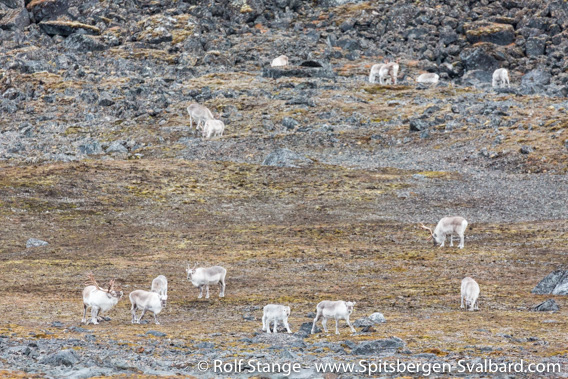
Unusually large group of reindeer in Krossfjord, an area where reindeer did not exist during decades or even centuries.
The key message: the total population of reindeer in Svalbard is now estimated at a good 22,000 animals. The “exact” number is 22,435, with a 95% confidence interval from 21,452 to 23,425. In 2009, the number was still estimated between 10,000 and 11,000. Today’s larger number may at least partly have to do with an actually increased population, including an increase in population because of recovery from past excessive hunting, as a consequence of protection in 1925, but the better quality and the more complete spatial approach are certainly also likely to be a significant factor influencing the now updated numbers.
Today, reindeer are even found again in remote areas as Kong Karls Land, where they did not occur over longer periods, although they existed there before Europeans started to frequent Spitsbergen in 1596, when Willem Barentsz discovered the islands.
The population density varies a lot between different areas. Vegetation is believed to be a key factor. In some areas, they may be up to 10 reindeer per square kilometre – locally, even more – while one animal will need the same area or more on its own to find enough food in sparsely vegetated areas such as the polar desert landscape of Nordaustland.
The recent study was published on 04 October: Mathilde Le Moullec et al (2019), A Century of Conservation: The Ongoing Recovery of Svalbard Reindeer. In: The Journal of Wildlife Management, Vol. 83, 1676-1686.
Fine for disturbance of polar bears in Tempelfjord
A man from Longyearbyen got a fine of 15,000.00 kroner (ca. 1500 Euro) because he disturbed polar bears during a private snow mobile tour in Tempelfjord in 10 March, 2018. He is said to have approached the bear with the snow mobile to a distance of 70 metres so the bears were visibly disturbed and moved away.
The incident was seen by witnesses who were out on tour on the neighbouring mountain Fjordnibba. The man was soon stopped by field police. A second man who was also involved could not be identified.
Because of the increase of snow mobile traffic, the Sysselmannen has announced to take strong action in such cases to make it clear beyond any doubt that the protection of the wildlife is of highest priority. In the current case, the fine has been imposed by the state advocate in north Norway, as revealed by the Sysselmannen.
The case caused some debate in social networks in Longyearbyen. Only a few days later the fjord ice in Tempelfjord, until then a popular destination both for locals and tourists, was closed for most motorised traffic.
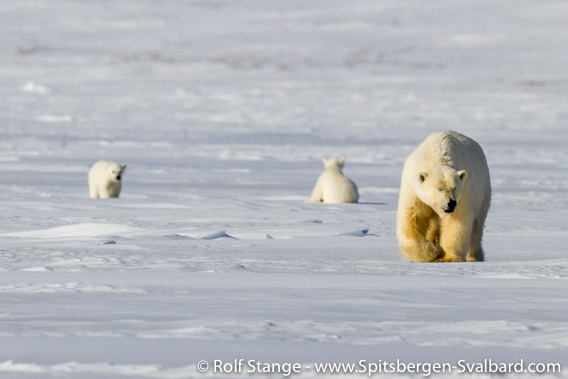
Polar bears in Tempelfjord (or elsewhere, for that matter): any disturbance is strictly forbidden.
According to the Spitsbergen environmental law (Svalbardmiljølov kapittel IV § 30) “it is forbidden to attract, to follow or seek out by any active act, polar bears so these could be disturbed or there may be danger for humans or polar bears (original text: Det er forbudt å lokke til seg, forfølge eller ved annen aktiv handling oppsøke isbjørn slik at den blir forstyrret eller det kan oppstå fare for mennesker eller isbjørn.)
Northguider: salvaging operation postponed until 2020
The salvaging operation of the shrimp trawler Northguider, that ran aground at Sparreneset in Hinlopenstretet in Svalbard in the end of December 2019, turned out to be more difficult than expected, as reported recently. Now it has been decided that further operations are postponed until 2020, according to a press release from Kystverket, the Norwegian coastal and maritime authority.
Due to the new information about the hull being more strongly damaged than thought before, new planning is needed and probably new technology, while the polar night is about to start in these latitudes.
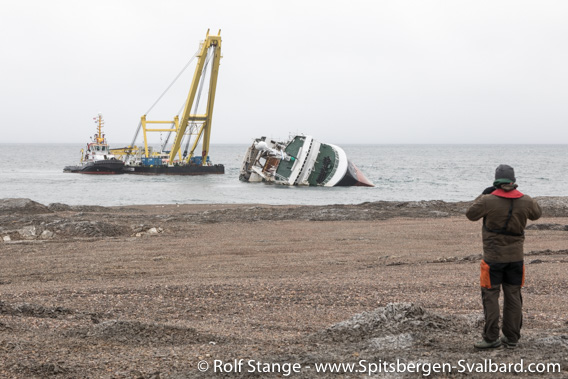
Grounded shrimp trawler Northguider at Sparreneset in Hinlopenstretet, august 2019.
In other words: nothing will happen with the wreck of the Northguider, which is still sitting on rocks just off the shore of Nordaustland, before the summer of 2020 – or, rather, nothing other than what the forces of nature, ice and weather, will do with the wreck. If there is then anything left to be salvaged in 2020 is something that only time can tell.
Salvaging Northguider proves more difficult
Salvaging the shrimp trawler Northguider, which ran aground in Hinlopenstretet in December last year, has turned out to be more difficult than thought before, as the Norwegian coastal adminstration authority Kystverket reports in a press release. The hull is more severely damaged than expected which makes the operation according to the initial plan impossible.
Northguider ran aground in late December 2018 at Sparreneset south of Murchisonfjord. The ship owner is required to remove the wreck within 2019, but this is now becoming doubtful: the polar night is soon to start, the sun will not rise above the horizon anymore for 4 months from late October. Shipping is not impossible during the dark season, but if a complicated salvaging operation can be carried out safely and successfully without daylight is an entirely different question.
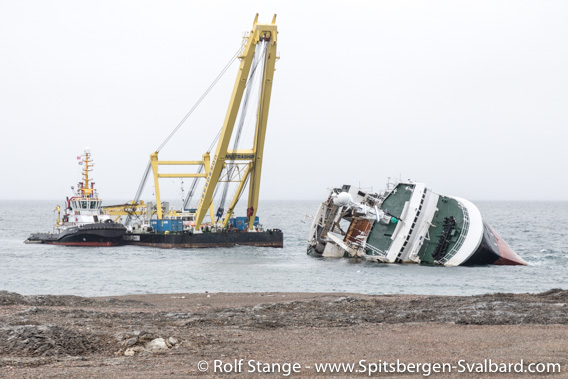
Salvaging vessels and the grounded trawler Northguider at Sparreneset in Hinlopenstretet, August 2019.
The salvaging vessels arrived on location only rather late in the summer, and then the operation was delayed repeatedly by severe ice and weather conditions. Only recently the wreck could be turned into an upright position and then it became appearent that damages on Northguider’s hull are far more extensive than expected. An area of 12×5 metres is said to be impacted.
Now all the players involved, including the coast guard, Kystverket, the ship owner Opilio AS, the insurance company and the salvaging company SMIT Salvage have to come up with a new plan. It appears rather unlikely that this will all happen within 2019. Officials have already mentioned postponing the operation until 2020 as an option. But if Northguider will still be there in the summer of 2020, after months on end with ice and severe weather, and in a condition that allows removing the wreck, will remain an open question until then.
Local government elections in Longyearbyen
A new local government (“Lokalstyre”) was elected in Longyearbyen yesterday (Monday, October 07). The municipal council has 15 members and elects the Lokalstyreleder (“mayor”) from these members. Lokalstyre administrates the area of the community of Longyearbyen, but does not decide on the politics in Svalbard beyond Longyearbyen.
Most votes were counted Monday evening. The result is not yet final, but major changes are not expected anymore. According to the preliminary result, Arbeiderpartiet (Ap, labour party, social-democratic) received most votes and will have 5 out of the 15 seats in the future community council. Venstre (V, a social-liberal party) got a few votes less but will also have 5 “Lokalstyremedlemmer” (community council members). Høyre (H, conservative party) and Fremskrittspartiet (right-wing libertarian party) will have 2 seats each. The local branch of Miljøpartiet De Grønne (green party) received a rather disappointing result and will only have 1 seat in the future community council, something that has certainly also to do with their election campain – not much was heard from Miljøpartiet De Grønne in Longyearbyen during the months and weeks before the elections.
Arild Olsen (Ap) has been Lokalstyreleder (mayor) since 2015. Both Olsen and Terje Aunevik (V) have chances to take the mayor’s chair in the future community council.
The voter participation was 61.7 %. All inhabitants are eligible to vote after a certain period which depends on their nationality.
Longyearbyen Lokalstyre was established in 2002, introducing local democracy in Svalbard’s largest settlement. Lokalstyre and the mayor are not to be confused with the Sysselmannen (“governor”), who is the highest representative of the Norwegian government. The Sysselmannen is not elected but appointed by the government in Oslo.
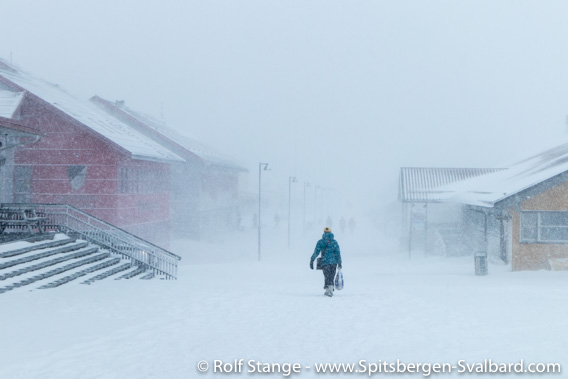
Lokalstyrevalg (community council elections) in Longyearbyen.
The council meets in “Næringsbyggget” (left).
News-Listing live generated at 2025/June/15 at 05:50:28 Uhr (GMT+1)



